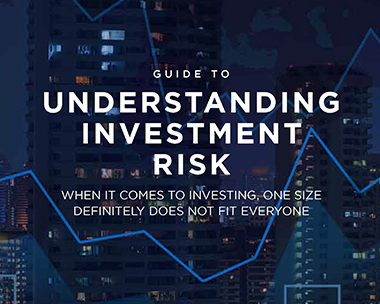There are many decisions to consider when making any investment. One of these is how much risk you are prepared to take. This will be determined by a number of different factors. In this guide, we take a look at the different types of investment risk and how it can relate to returns.
Your appetite for risk will depend on your life stage and whether you want to grow your money over the long term or need to draw a regular income. Usually, your age and relative proximity to retirement will determine whether you’re investing for the short term (one to three years), medium term (three to five years) or long term (more than five years).
What to invest your money in is a big decision. To make an informed recommendation, it is important for us to understand your financial circumstances, your investment objectives and expectations, including the level of risk you are prepared to take and that which you can afford to take. If you want to invest for many years, you may be prepared to take on more risk in your investment portfolio. This means you’ll have time to ride out any short-term fluctuations in investment returns and benefit from the potentially higher returns offered by growth investments such as shares.
As you approach retirement, or when saving for a specific goal such as the purchase of a home, you are less willing to risk losing your money. This is particularly true when markets are volatile, and the risk of capital loss increases. At this time, you might put a greater emphasis on investing in defensive assets, such as cash and fixed income.
Different types of investment
None of us likes to take risks with our money, but the reality is there’s no such thing as a ‘no-risk’ investment. You’re always taking on some risk when you invest, but the amount varies between different types of investment.
As a general rule, the more risk you’re prepared to take, the greater returns or losses you could stand to make. Risk varies between the different types of investments. For example, funds that hold bonds tend to be less risky than those that hold shares, but there are always exceptions.
There are various different risks associated with investing. In this guide, we highlight the main areas you need to consider.
Losing value in real terms
Money you place in secure deposits such as savings accounts risks losing value in real terms (buying power) over time. This is because the interest rate paid won’t always keep up with rising prices (inflation).
On the other hand, index-linked investments that follow the rate of inflation don’t always follow market interest rates. This means that if inflation falls, you could earn less in interest than you expected.
Inflation and interest rates over time
Stock market investments might beat inflation and interest rates over time, but you run the risk that prices might be low at the time you need to sell. This could result in a poor return or, if prices are lower than when you bought, losing money.
You can’t escape risk completely, but you can manage it by investing for the long term in a range of different things, which is called ‘diversification’. You can also look at paying money into your investments regularly, rather than all in one go. This can help smooth out the highs and lows and cut the risk of making big losses.
Capital risk
Your investments can go down in value, and you may not get back what you invested. Investing in the stock market is normally through shares (equities), either directly or via a fund. The stock market will fluctuate in value every day, sometimes by large amounts. You could lose some or all of your money depending on the company or companies you have bought. Other assets such as property and bonds can also fall in value.
Inflation risk
The purchasing power of your savings declines. Even if your investment increases in value, you may not be making money in ‘real’ terms if the things that you want to buy with the money have increased in price faster than your investment. Cash deposits with low returns may expose you to inflation risk.
Credit risk
Credit risk is the risk of not achieving a financial reward due to a borrower’s failure to repay a loan or otherwise meet a contractual obligation. Credit risk is closely tied to the potential return of an investment, the most notable being that the yields on bonds correlate strongly to their perceived credit risk.
Liquidity risk
You are unable to access your money when you want to. Liquidity can be a real risk if you hold assets such as property directly, and also in the ‘bond’ market where the pool of people who want to buy and sell bonds can ‘dry up’.
Currency risk
You lose money due to fluctuating exchange rates.
Interest rate risk
Changes to interest rates affect your returns on savings and investments. Even with a fixed rate, the interest rates in the market may fall below or rise above the fixed rate, affecting your returns relative to rates available elsewhere. Interest rate risk is a particular risk for bondholders.
Investment diversification
Diversifying your investments means spreading them around so you also spread your risk. Many people invest across the main asset classes such as shares, property, cash and fixed income, and also invest in a number of different areas within each asset class.

